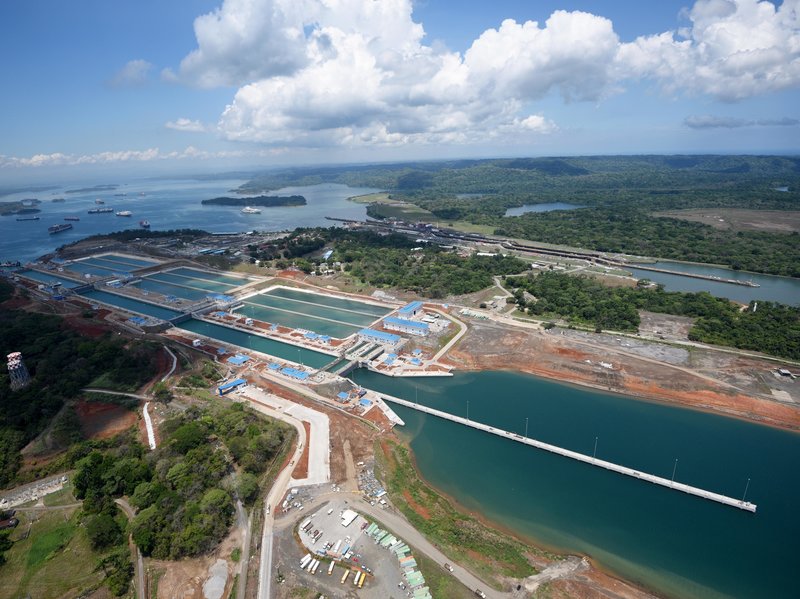Ten years in the making, the much-awaited third lane in the Panama Canal is now open. This $5 billion project promises to reorient the landscape of the logistics industry. However, the canal’s inauguration comes at one of the most difficult financial times for the shipping industry as international trade falters, due in part to the economic slowdown in China.
The current slump wasn’t part of the calculation when Panama decided to expand the canal back in 2007, just before the global recession. Back then, the industry was moving towards bigger and bigger ships that would no longer fit through Panama’s existing locks and they were losing traffic to rival Suez Canal. This expansion was more to compete with the rival Suez Canal rather than to accommodate the demand/capacity conundrum.
Anders Boenaes, vice president at Maersk, the world’s largest shipping company, said that Panama had to expand the canal to stay competitive and that they can likely win back what had been changed to the Suez over the past decade.
The expansion makes the Panama Canal more competitive with the Suez Canal in Egypt, shortening the one-way journey by sea from Asia to the U.S. East Coast by roughly five days and eliminating the need for a trip around Cape Horn to get to the Atlantic. Expansion was a must in order for the Panama Canal to continue to play its key role in global trade.
It is expected to shift about 10% of the Asia-to-U.S. container traffic from West Coast ports to East Coast terminals by 2020, according to a recent report by global business adviser Boston Consulting Group and supply-chain management provider C.H. Robinson Worldwide Inc. So far, 136 ships that wouldn’t have fit through the pre-expansion canal have made reservations.
In terms of capacity, some 6% of global trade, or 340 million tons of goods, passed through the canal last year. Still, it has lost 10%–15% of annual revenue to the Suez Canal over the past three years, according to canal executives. Earlier this month, the Suez Canal cut its tolls by up to 65% for certain trades, including routes from Asia to the U.S. East Coast in an effort to fight back against the competition.
The current expansion of the Panama Canal has the potential to shake up the existing dynamics of West Coast and East Coast ports as the larger ports on the West Coast will experience lower growth rates. Traffic had already been shifting east for several reasons, including labor disputes at Los Angeles-Long Beach. East Coast ports’ share of containers from Asia to the U.S. rose to 31% in 2015, up from 26% in 2012, according to Drewry Maritime Research. This new order will also shape the investment and routing decisions of rail and truck carriers, magnify the trade-offs that shippers make between the cost and the speed of transportation, and potentially alter the location of distribution centers.
To send goods to the Midwest from Asia, it is generally cheaper to use the canal route to the East Coast and the Gulf states, because the cargo travels fewer miles on costly rail and truck routes. Ports on the East Coast and Gulf of Mexico, including New York, Miami and Houston, have been investing heavily to bear the fruit of the Panama Canal expansion. They have deepened their harbors, expanded rail lines and installed massive cranes. The Port Authority of New York and New Jersey spent more than $1 billion to raise the level of the Bayonne Bridge to allow for big ships to pass under the roadway.
It is clear that there will be two maritime battles: one between the Panama and Suez Canals and the other between West and East Coast ports. At the end, shippers will make their choices based on factors including the value of their cargo, transportation costs, transit time, service levels, and flexibility.
A study conducted by The Boston Consulting Group and C.H. Robinson analyzed four different types of products, tires, couches, tee shirts and industrial pumps that would be shipped from East Asia to the mid-west market, Columbus, Ohio. These four products broadly represent the range of goods in the four top categories of imports that make up more than three-quarters of East Asia container traffic into the U.S. They also represent different combinations of profitability, size and time sensitivity.
If costs were all that mattered, shippers would route all these products through an expanded Panama Canal to reach Columbus via rail from the New York-New Jersey port. At current market rates, that route would be about 4 percent cheaper than one going through Oakland. But, it also would take 11 days longer, which means the amount of inventory in transit would increase and the seller will need to stock more inventory as a buffer to account for the demand during those additional 11 days.
After considering these factors and doing the math for these four products, the savings gained by transporting tires and couches to the Columbus region through the Panama Canal are large enough to more than make up for the extra inventory that shippers will need to carry. But, the analysis works out the opposite way for tee shirts and pumps. The time advantage of shipping through the West Coast trumps the cost savings of East Coast travel.
Shippers and distribution managers would need to make a conscious effort to evaluate the impact in terms of costs and service levels and then leverage the alternate canal that has opened up rather than continuing business as usual.
The Panama Perspective welcomes this guest post from Vengat Narayanasamy, of GEP.
